The rules for Reanimation Protocol have been released. Is it what we need? Is it what we wanted?
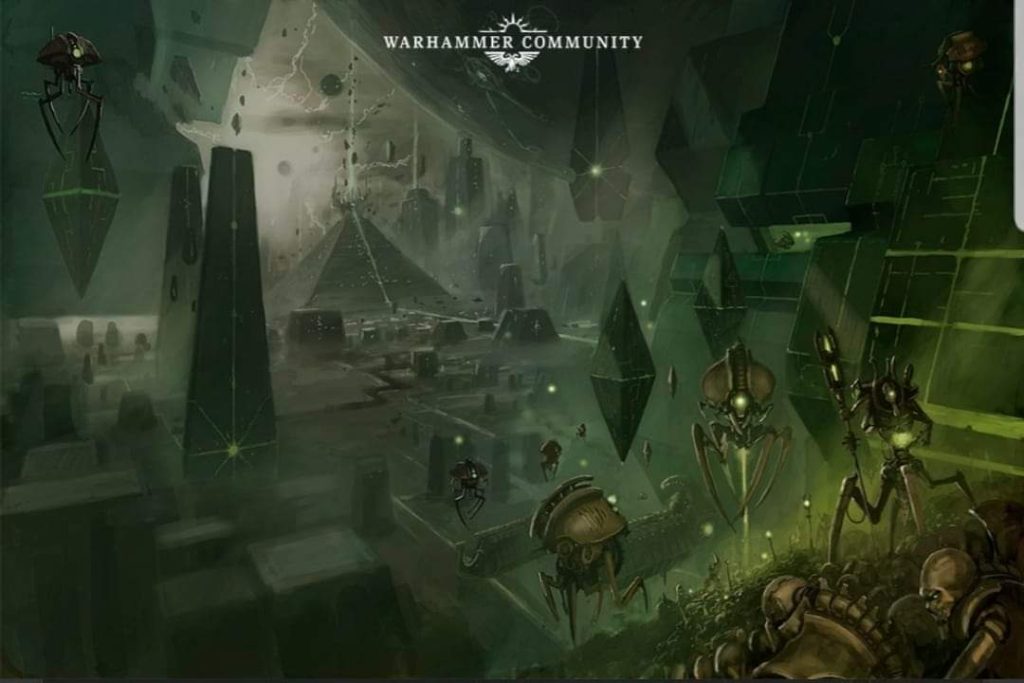
With no prelude… here is the text.
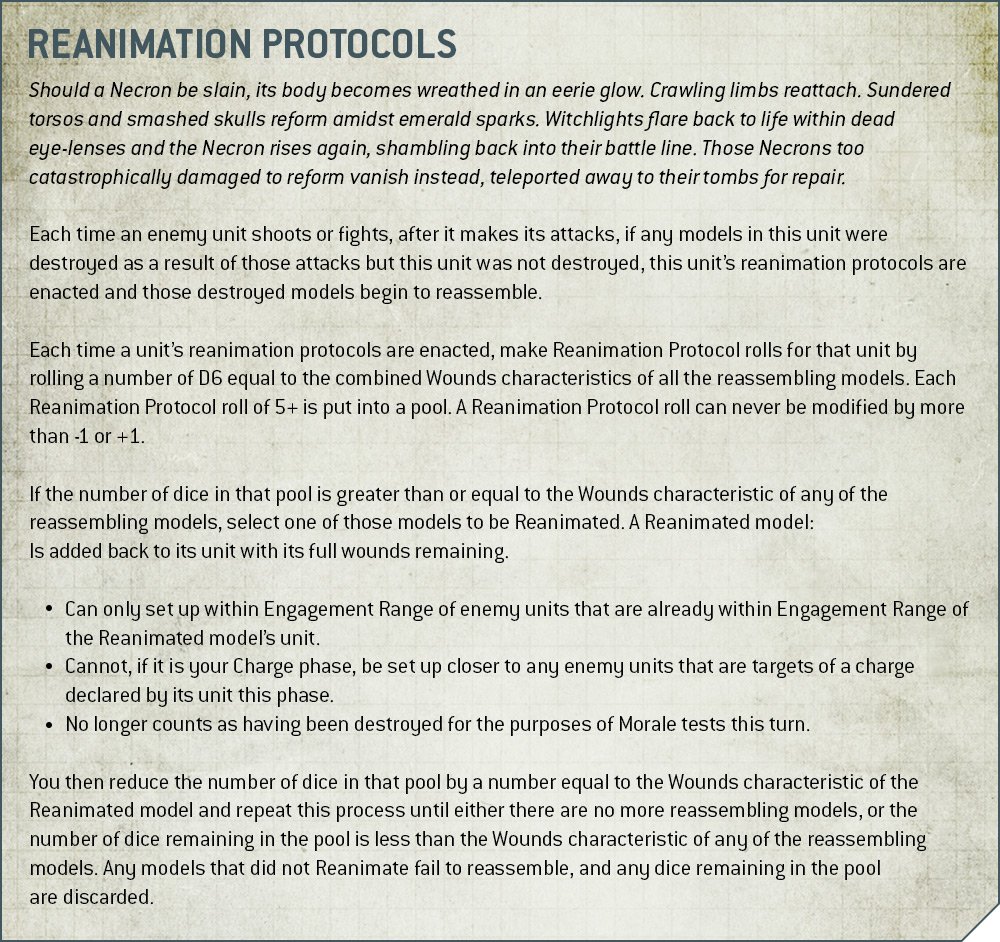
The five W’s
Who? – Necron units with the Reanimation Protocol rule. I’m basing this on the Edge of Silence book from Indomitus, though GW can completely change anything in that book when it comes to the codex release. Right now, we’ve seen this rule on the Skorpekh Destroyers, Cryptothralls and Necron Warriors, but not any of the characters or other canoptek units.
What? – make a save in a way that is completely unlike any other save we have seen in this game or Age of Sigmar. It’s … just weird. I’m struggling to put it into words.
Where? – Uh… slavish adherence to form… sorry.
When? -It happens after every attack. Specifically, after every unit shoots or fights. It isn’t after ever weapon gets fired or every type of weapon is used in a melee attack, but after a whole unit goes.
Why? – Games Workshop seems committed to giving the Necrons some flavor through this rule. I’m all for this.
How? – Savish adherence to form again… sorry, again.
What is the save?
It’s been taking me a long time to write a summary of this rule.
It’s not like Feel No Pain or Disgustingly Resilient, where you roll on each wound and if you are successful you ignore that wound.
It’s not like earlier editions of Reanimation Protocol, where you only roll once per model and it comes back full or not at all.

Another example: In the Assault phase, an enemy unit targets and makes its attacks against a large unit of Warriors, destroying 8 models. The Warrior unit can now make reanimation protocol rolls. Each warrior only has a single wound, so you roll eight dice for the unit, and any rolls of one can be rerolled due to Their Number is Legion on the Warrior Datasheet. After rerolls you get 1, 2, 2, 4, 4, 5, 5, and 6. You would put three dice into a pool. This pool contains enough dice to reanimate three of the destroyed Warrior models. They return to the unit and can be set up in the engagement range of a unit, ready for their swing at the opponent.
What did Games Workshop get right?
In my article a few weeks ago, I hoped that Games Workshop would address a list of things.
- Balance between large and small games
- Balance between large and small units
- Creates interesting play decisions for the Necron player and opponent
- Interesting flavor
- No clunky bookkeeping to slow the game down
I’ll take these items one by one, but I’ll save the balance questions for last.
Interesting Plays
Does this mechanism create interesting plays and play decisions? YES!
My main complaint about 8th edition Reanimation Protocols was that it created a very simple decision tree. If there was a partially wounded unit, target it. If there isn’t a partially wounded unit, target the next threat. This new rule is a big step up from that!
First, an opponent can leave a unit at diminished efficiency without the worry of it literally returning to full strength a few turns later. This may be important for scoring in later turns or just creating a situation where a different squad can be targeted. More choices… more chances for the opponent to make the wrong choice.
It also creates interesting decisions for the Necron player in close combat. Imagine a multi-unit combat where multiple enemy models are engaged with a single large Necron unit. The Necron player can shift resurrected models away from the unit that has already attacked and place them within engagement range of a unit that hasn’t gone yet. Also, the Necron player can mess around with unit coherency a bit to place the reanimated models out of melee range of the second enemy unit.
I’m actually a pretty bad player… but I’m sure that there are other interesting plays that this rule allows great players to pull off. The chance to move a model during your opponent’s shooting phase or between units chosen to fight makes Reanimation Protocols better than Disgustingly Resilient!
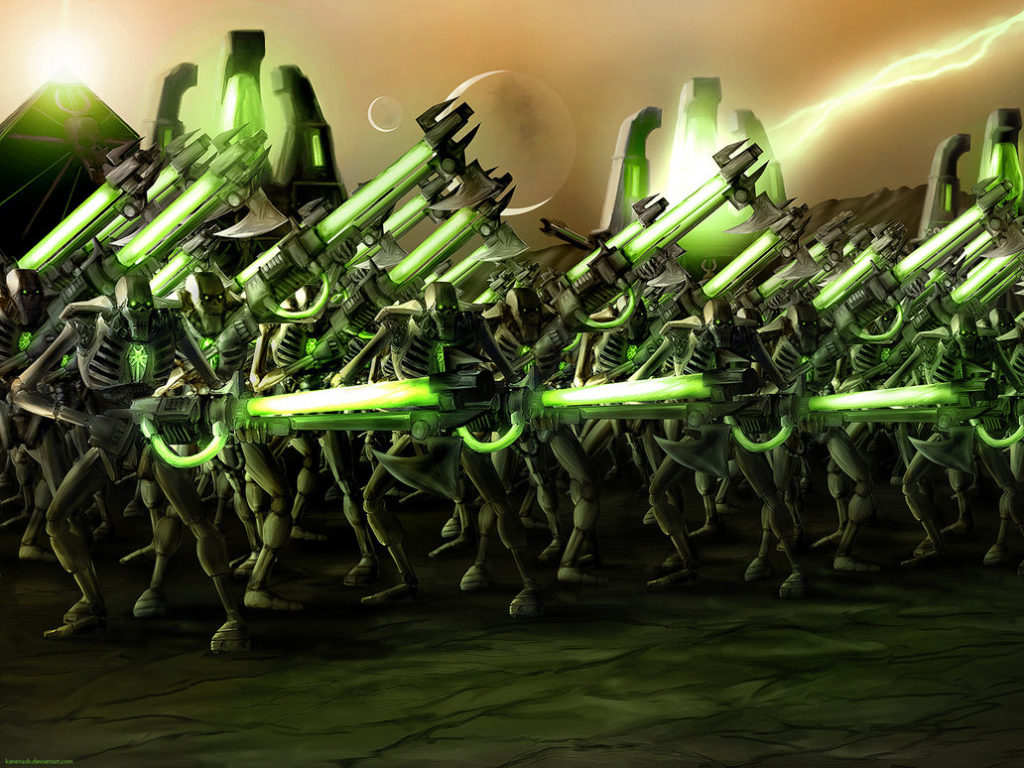
Interesting Mechanic
Is this an interesting mechanic? Yes… yes, it is.
Once it was announced that Reanimation Protocol would be after every attack, I was seriously worried that we would be returning to a 7th Edition style save-after-a-save mechanic. Luckily it isn’t just a Feel No Pain or Disgustingly Resilient… there is some meat to it. Models are removed… and then return. It feels very much like Reanimation… not just shrugging off wounds.
As mentioned above, it allows for repositioning, something that isn’t a part of the ignore-a-wound rules. The twist of rolling per wound is something that I had hoped for, but how it is implemented certainly took me off guard and I feel is a fair exchange for the added mobility. (I just wish I was a good enough player to take advantage of it!)
Clunky Bookkeeping?
No… no real bookkeeping needed, but it does slow the same down a bit. Our large-sized units are all single wound models, and there isn’t much in terms of decision making to do. It is a single roll for each wound after a unit attacks… and that will take time.
At least reanimated Necrons will get to continue participating in the phase in which they reanimated. There is no waiting until the end of the phase or the start of the next turn.
Speed play Tip… Necron players will need to pick up failed saves… then roll them again as Reanimation Protocol rolls. If you have a multi-wound unit… you’ll need to add dice for any wounds already suffered on a model, so have those ready.
Balance in game size
My previous complaint was that Reanimation Protocols was overwhelming at low points, and almost trivial at larger point games.
In low point games, Reanimation Protocols was overwhelming because units wouldn’t stay at reduced capacity… in this version, units will. If you truly kill 8 warriors out of a 20 warrior blob… they won’t be getting up at the beginning of the next turn.
In large point games, it was easy to wipe a unit without allowing them to have Reanimation Protocol saves at all. Now, unless you have a unit with truly withering firepower, the Necrons will at least get one Reanimation Protocol before being targetted by a second unit. It is clearly better than waiting for the end of the phase or the beginning of the next turn.
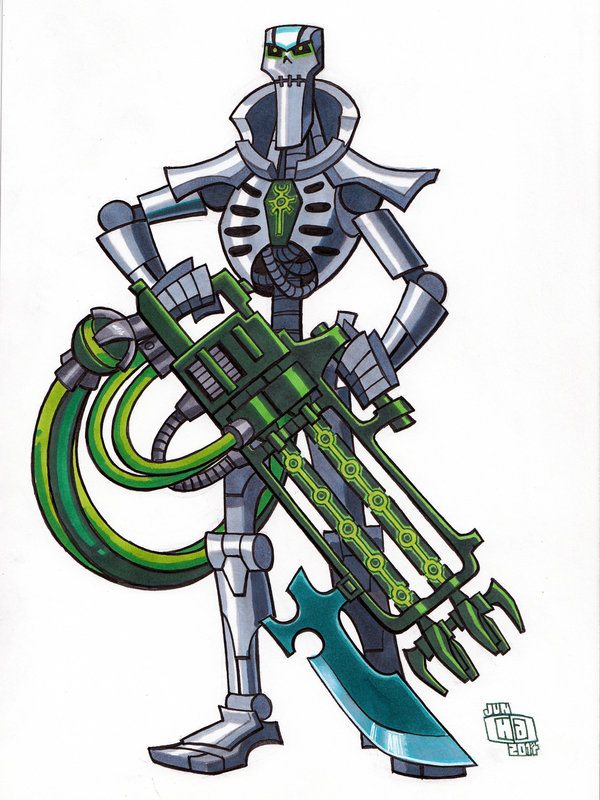
Balance between unit sizes
My previous concern was the disparity of how Reanimation Protocols treated units like Destroyers and warriors. The old version of Reanimation Protocols clearly benefited the larger, but weaker models in the Necron army. The enemy needed to remove only 6 destroyer bodies compared to 20 warrior bodies in order to deny the respective units from reanimating.
First, I feel it is way too early to say anything about how Reanimation Protocols works with Characters… if at all. Characters in Eighth Edition and the Indomitus box didn’t have the rule… and so may not have it. Although, they will likely continue to have a rule like Living Metal.
Reanimation Protocols are much simpler when doing one wound models… roll a die for each model removed, and it comes back with a success. On multi-wound models, things get more complex. You must have enough dice in the success pool to completely reanimate the model. If you have a unit with three wounds, and only get two successes you are out of luck. The more wounds that the models in the unit have, the more likely you are to not have enough successes to reanimate the models that you’ve lost.
If you are relying on multi-wound models, modifiers to Reanimation Protocols will be all that more important to your army.
What we don’t know
I feel that it is important that we acknowledge what we don’t know.
We don’t know what models give buffs to Reanimation Protocols, other than the Canoptek Reanimator. We don’t know if Crypteks will continue to have the Technomancer ability or if it will work in the same way.
We don’t know what stratagems, relics, Dynastic Codes, or command protocols have in store for us… anyone could seriously change the playing field in terms of Reanimation Protocols on multi-wound models. (For instance, imagine a Skorptehk Lord with a relic that makes each successful Reanimation Protocol roll add two dice to the dice pool instead of one or a Dynastic Code that gives all Destroyer units a +1 to Reanimation Protocol rolls.)
So how do I feel about it?
Honestly, I’m excited. This mechanic meets at least four of my five desired outcomes. I don’t know if it is powerful enough to keep Necrons near the top of competitive play as the many waves of codexes follow, but I know that it is certainly better than what we had.
I can’t wait for the codex… we know that it must be soon. Just the additional layers of rules that Necrons will have… Command Protocols on top of what we already had with Dynastic Codes.. leaves me very excited.
Oh, and this thing.
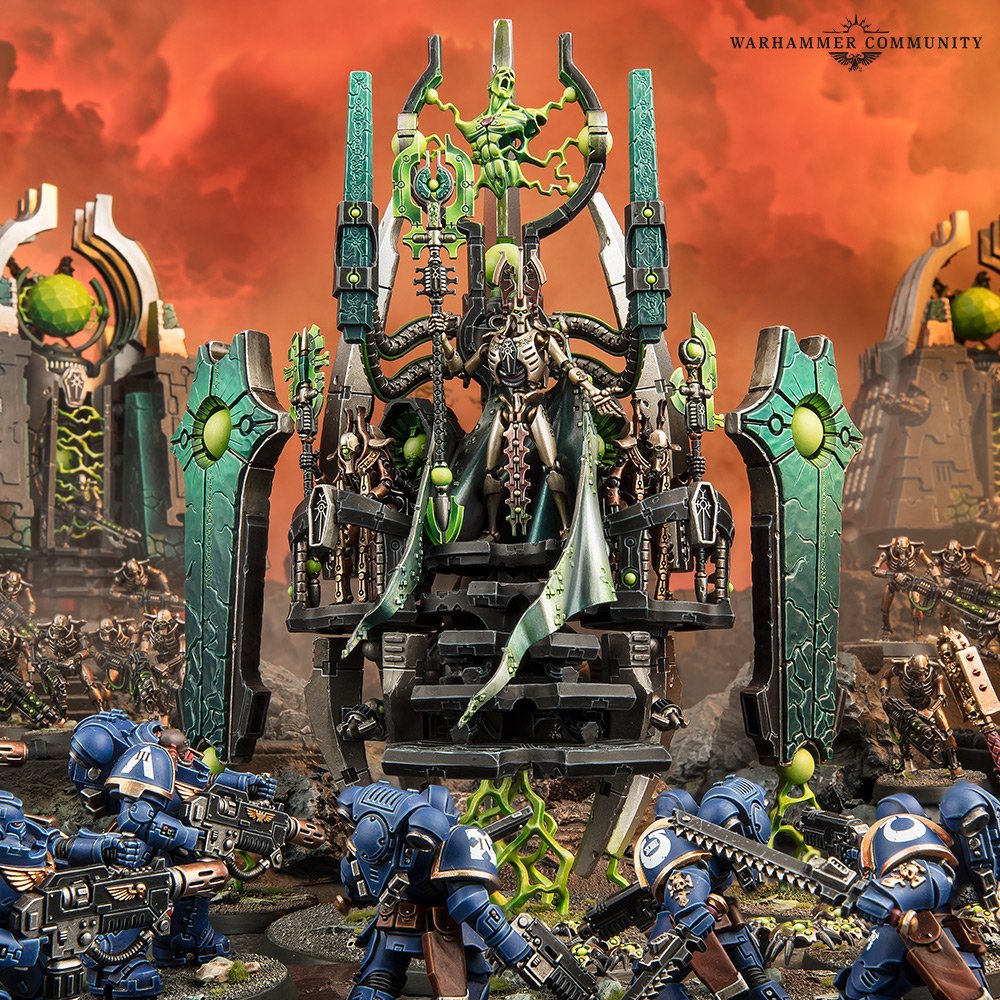
Until then,
Best Blitzes!
Dolch
Subscribe to our newsletter!
And remember, Frontline Gaming sells gaming products at a discount, every day in their webcart!


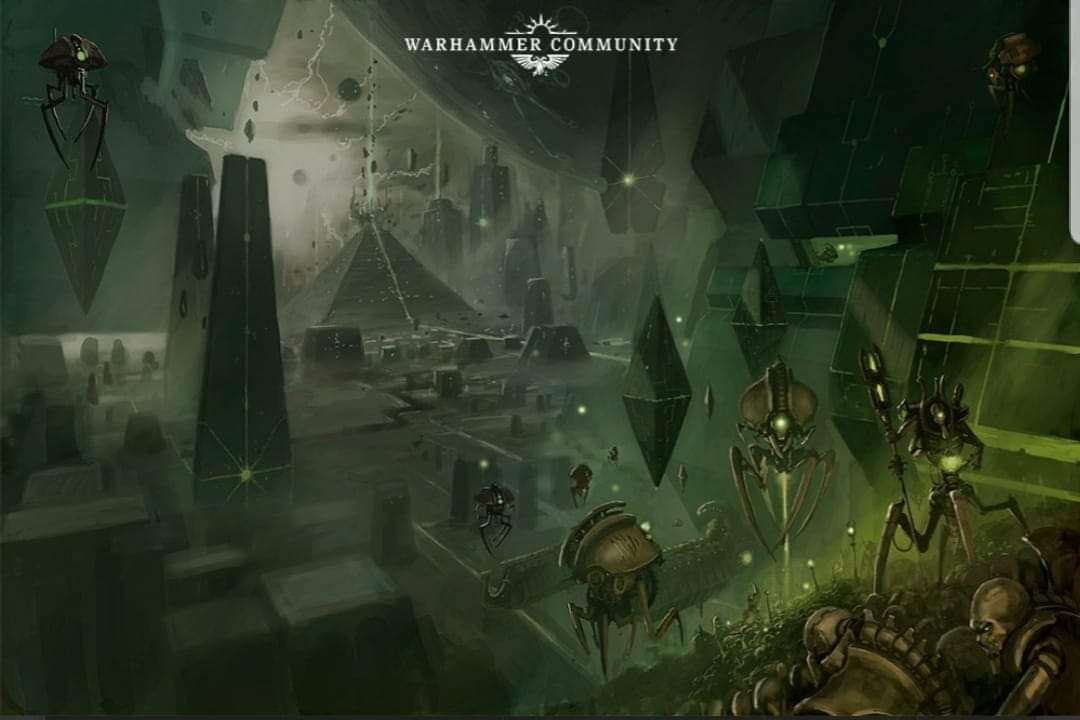

As it is, it’s kind of a big nerf for multiwound models. The odds of reviving a single dead Destroyer, for example go from 33% to about 3% (need to roll three 5+s). The numbers look better the more models they kill, but they’re never as good as the flat per-model 5+. Activating on each attack is a huge buff and makes it much more usable, but the new (somewhat convoluted method) does have some significant downsides for all the new Destroyer (and recently buffed Lychguard and Praetorian) lists.
Also it is only shooting and assaulting attacks let you use RP rule.
So bombing runs, psykic attacks, exploding vehicles, hell even having your Lychguard take a hit from snipe attacks will not let you use the rule.
So yeah as far as I see without any more support (assuming crypteks give a +1 only) this is only a rule for mobs of Warriors of Immortals. The silver tide was tried a lot by a lot of good players and it is not an army that functions anymore with how lethal the game is. With the new units that Space Marines are getting game is trending even more toward that.
We will know in a week with the full rules and points if Necrons can float in the game or will be stuck at the bottom of the pond.
The Art of war had an Aussie on that won with Necrons at a tourny, I and Nick were chomping at the bit on how he did it. (There were only 3 SM players there is how and he missed them, the meta there was bored with them)
Yes… only with Reanimation Protocols only being active during the shooting and assault phases… it’s different. But again… Different is good!
Lol why is different automatically good? By that logic, nothing could ever get worse since the very act of changing it would make it good ?
Definitely a nerf, though it has interesting possibilities for close combat. I’m not sure I like that you only get one chance to bring the models back. Once you fail, the unit is permanently diminished.
I don’t get how people say this is a nerf. This is a nearly guaranteed chance at coming back, as opposed to a nearly guaranteed chance that you DON’T come back.
Like, sure, the roll is worse for multi-wound models, but the point is that you’ll GET THE ROLL! That simply means getting it back more often than before, which means that even if the dice roll is worse, the frequency of those rolls means that this is a BUFF.
Like, do you want 1% of $million, or 99% of $100? Yeah, it’s a lot lower percentage, but of a much larger number, so the total is WAY bigger. Same thing here. The chances of getting them back is way worse, but the frequency that you get to have a chance at bringing them back will be far greater!
I agree. What we know about Reanimation Protocols is great for our Warriors, and pretty ok for our 2 wound models too. Totally not a nerf.
Is it great for our destroyers? No, but once again they aren’t going to be where our support characters are either. Maybe we have a ‘Tale of Two Armies’ within one… we have our Immortals and Warriors with our support characters holding objectives and occupying the center table. Then we also have destroyers, tombblades and their like as counter-charge and objective clearing units without much support. We already know Destroyers are not going to need to have My WIll Be Done, since they already get some rerolls to hit/wound. Maybe these units just won’t need reanimation protocols in order to be useful.
Like I said in the article, strategems, relics, Command Protocols and Dynasty Traits will make a huge difference… and we just don’t know what all of them are yet.
Ok, yes you will get the first roll more often. But it’s much harder to succeed on that roll for most of the codex (anything with more than one wound) and you only get to roll once for any one model. You also don’t get any roll at all for mortal wounds. So you end up with less rolls that are harder to pass.